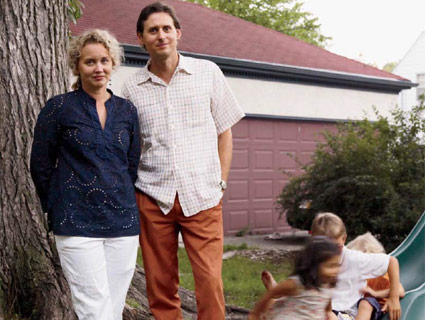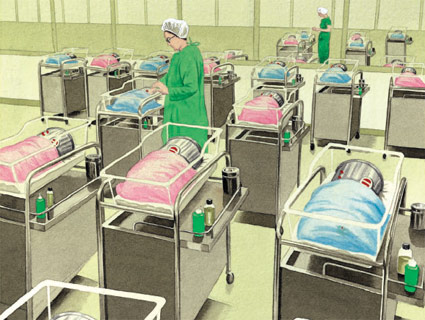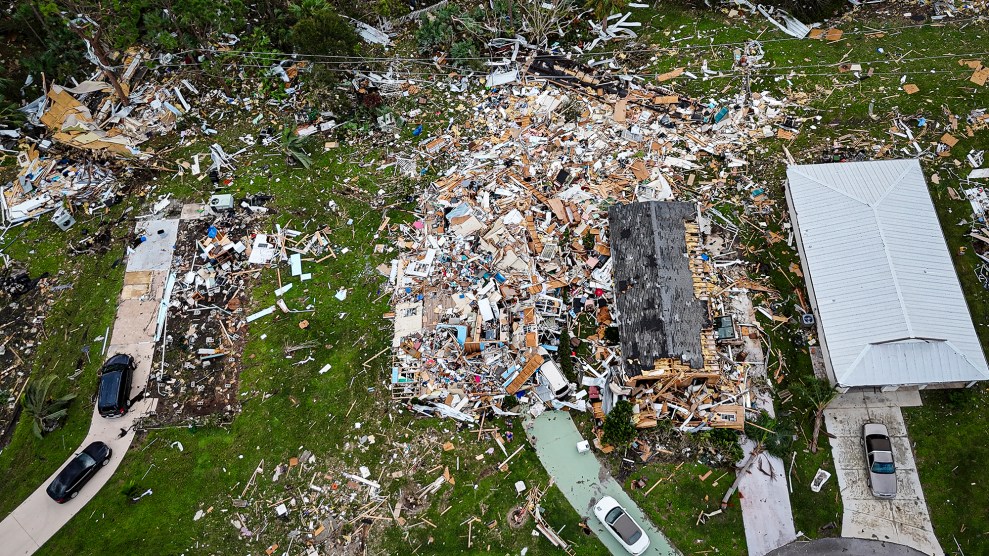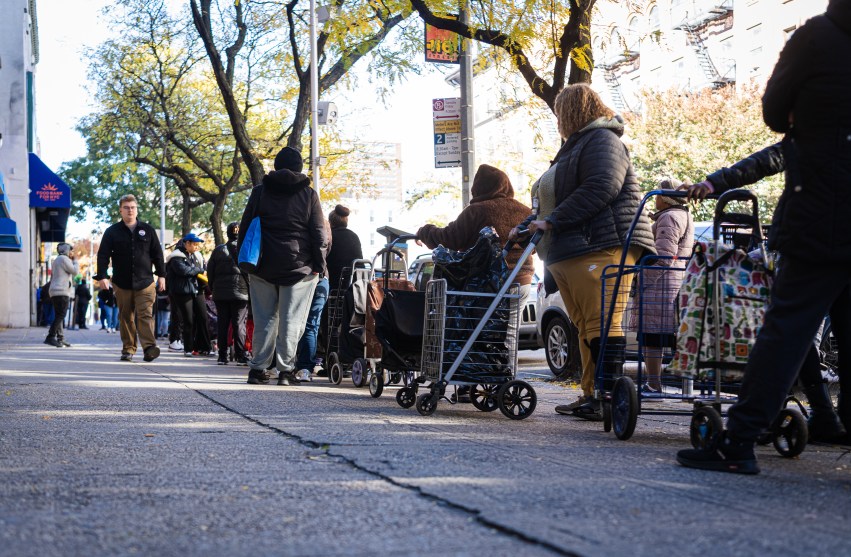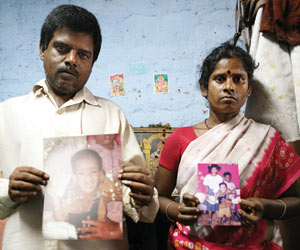
Photo: Scott Carney
This piece just won the Payne Award for Ethics Journalism. Read more about why here.
Listen to an interview with the author.
After hours hunched behind the wheel of a rented Kia, flying past cornfields and small-town churches, I’m parked on a Midwestern street, trying not to look conspicuous. Across the way, a preteen boy dressed in silver athletic shorts and a football T-shirt plays with a stick in his front yard. My heart thumps painfully. I wonder if I’m ready to change his life forever.
I’ve been preparing for this moment for months in the South Indian metropolis of Chennai, talking to khaki-clad officers in dusty police stations and combing through endless stacks of court documents. The amassed evidence tells a heartrending tale of children kidnapped from Indian slums, sold to orphanages, and funneled into the global adoption stream. I’ve zeroed in on one case in particular, in which police insist they’ve tracked a specific stolen child in India to a specific address in the United States. Two days ago, the boy’s parents asked me to deliver a message to the American family via their lawyer, seeking friendship and communication. But after traveling across 10 time zones to get here, I’m at a loss for how to proceed.
The dog-eared beige folder on the passenger seat contains the evidence—a packet of photos, police reports, hair samples, and legal documents detailing a case that has languished in the Indian courts for a decade. There’s a good chance that nobody in this suburban household has a clue. I wait until the boy ambles around to the back of the house, then jog over and ring the bell.
An adolescent Indian girl with a curious smile answers the door. “Is your mother home?” I stammer. Moments later, a blond woman comes to the door in jeans and a sweatshirt. She eyes me suspiciously.
On February 18, 1999, the day Sivagama last saw her son Subash, he was still small enough to balance on her hip. Sivagama—who, like many in the state of Tamil Nadu, has no last name—lives in Chennai’s Pulianthope slum, a place about as distant from the American Midwest culturally as it is in miles. Children play cricket in bustling streets swathed in the unbearable humidity that drifts in from the nearby Indian Ocean. Despite the hubbub, it’s considered a safe area. Unattended kids are seldom far from a neighbor’s watchful eye.
So when Sivagama left Subash by the neighborhood pump a few dozen feet from their home, she figured someone would be watching him. And someone was. During her five-minute absence, Indian police say, a man likely dragged the toddler into a three-wheeled auto rickshaw. The next day, Subash was brought to an orphanage on the city’s outskirts that paid cash for healthy children.
It was every parent’s worst nightmare. Sivagama and her husband, Nageshwar Rao, a construction painter, spent the next five years scouring southern India for Subash. They employed friends and family as private detectives and followed up on rumors and false reports from as far north as Hyderabad, some 325 miles away. To finance the search, Nageshwar Rao sold two small huts he’d inherited from his parents and moved the family into a one-room concrete house with a thatched roof in the shadow of a mosque. The couple also pulled their daughter out of school to save money; the ordeal plunged the family from the cusp of lower-middle-class mobility into solid poverty. And none of it brought them any closer to Subash.
In 2005, though, there was a lucky break. A cop in Chennai heard reports of two men arguing loudly about kidnapping in a crowded bar. Under questioning, police say, the men and two female accomplices admitted they’d been snatching kids on behalf of an orphanage, Malaysian Social Services (mss), which exported the children to unwitting families abroad. The kidnappers were paid 10,000 rupees, about $236, per child.
According to a police document filed in court, the orphanage’s former gardener, G.P. Manoharan, specifically confessed to grabbing Subash; records seized from mss show that it admitted a boy about the same age the next day—the same day Nageshwar Rao filed his missing-person report. He was adopted about two years later. The surrender deed, which I reviewed along with similar documents for other kids, is a fraud, police say: The conspirators changed the child’s name to Ashraf and concocted a false history, including a statement from a fictitious birth mother.
From 1991 through 2003, note documents filed by Chennai police, mss arranged at least 165 international adoptions, mostly to the United States, the Netherlands, and Australia, earning some $250,000 in “fees.”
Assuming the Indian police have their facts straight, the boy they seek has a new name and a new life. He has no memory of his Indian mother or his native tongue. Most international adoptions are “closed,” meaning the birth parents have no guaranteed right to contact their child, and the confidentiality of the process makes it difficult to track kids who may have been adopted under false pretenses.
After Subash disappeared, Sivagama fell into a deep depression. Ten years later, she’s still fragile, her eyes ringed by heavy dark circles. At the mention of her son’s name, she breaks into tears, dabbing at the corners of her eyes with her sari.
“Why should we pay like this,” she pleads, “for what criminals started?”
And why would a crowded orphanage conspire to steal children off the streets? Perhaps Subash was viewed as particularly adoptable due to his light skin and good health. In Chennai, hoping to learn more, I negotiate my tiny black Hyundai past an endless stream of lorries, rickshaws, and stray cattle toward the outskirts of the city, where mss is located. It has closed the orphanage and no longer does international adoptions, but still runs several social programs and a school for young children.
I pull up outside the bright pink building, get out, and peek through the wrought-iron gate. A man in a crisp white shirt promptly intercepts me and then introduces himself as Dinesh Ravindranath, a name I recognize from police reports that list him as an accomplice in the kidnappings. He says he has been running mss since his father died in 2006. He’s also its lawyer.
Ravindranath tells me the investigation of his organization—which made headlines in India—has been blown out of proportion; he’s the real victim here. The police, he alleges, have been using their investigation to extort money from the institution. “The law says that we cannot ask too much about the history of a woman who wants to give up her child to adoption, so we have to accept children on faith,” he says.
But surrender deeds obtained by Mother Jones bear the signatures of mss officials alongside those of the suspected kidnappers, who have admitted to handing over multiple children under different aliases. When I press Ravindranath about the fees the suspects told police they’d received from mss, he claims the situation was misconstrued. “We give the women 2,000 or 3,000 rupees [about $47] when they come here out of charity, not as a fee for kidnapping,” he says. “This happens everywhere. We are only the scapegoats.”
The problems with adoption are certainly widespread. Over the past decade, scandals in Delhi and the Indian states of Gujarat, Andhra Pradesh, Maharashtra, and Tamil Nadu have exposed severe breaches of adoption protocol and claims by parents who have lost children to foreign families. The promise of lucrative adoption fees motivates orphanages to create a steady supply of adoptable children. (It costs about $14,000 to bring a child to the United States from India, not including the standard $3,500 fee to the orphanage.) In the most egregious cases, once-respected agencies get wrapped up in child trafficking, and well-meaning American families never realize they’re not adopting a child—they’re buying one.
The scandals aren’t limited to India. In 2007, employees at the French charity Zoe’s Ark were arrested trying to fly out of Chad with 103 children they claimed were Sudanese war refugees; police later determined that most of the kids had been stolen from families in Chad. In China’s Hunan province, a half-dozen orphanages were found to have purchased nearly 1,000 children between 2002 and 2005, many of whom ended up in foreign homes. Last spring, an abc News team discovered that some institutions in the region were still purchasing children openly for $300 to $350.
In 2006, celebrity watchers were riveted by Madonna’s adoption, from a Malawi orphanage, of David Banda, a child who was not, in fact, an orphan. More recently, in January, workers from the Utah adoption agency Focus on Children pleaded guilty to fraud and immigration violations; according to a federal indictment, they had imported at least 37 Samoan children for adoption after misleading the birth parents and telling prospective adoptive parents that the kids had been orphaned or abandoned. “This is an industry to export children,” says Sarah Crowe, unicef‘s media director for South Asia. “When adoption agencies focus first on profits and not child rights, they open up the door to gross abuses.”
The Hague convention on intercountry adoption, which addresses this type of criminal exploitation, was ratified by 50 countries—the United States signed on in 2007—but the pact is toothless, according to David Smolin, a law professor at Alabama’s Samford University who has adopted two children from India. “The Hague itself has the weakness of relying on [the] sending countries to ensure that the child was properly relinquished,” Smolin told me via email. “Receiving countries cannot afford to simply take the sending country’s word.”
Smolin should know. His adopted kids were placed in orphanages in Andhra Pradesh by their birth mother to receive an education—a practice not uncommon among India’s poor. But the illiterate mother was tricked into signing a surrender deed at the outset and was later turned away when she tried to regain custody. The girls, 9 and 11, had been coached to say their father was dead and their mother had given them up, but they eventually told the Smolins the truth. The American adoption agency refused to look into the matter. By the time the family tracked down the birth parents, six years had passed, and the girls had acclimated to life in Alabama. Although the kids remain here, the Smolins opened up the adoption; they have traveled to visit the Indian family and kept in regular contact.
Smolin has since retooled his legal career, and he is now among the nation’s leading advocates of adoption reform. The Hague convention’s biggest flaw, he notes, is that it doesn’t cap the adoption fees paid by rich countries. “If you don’t sharply limit the money, all of the other regulations are doomed to failure,” Smolin says.
Police, lawyers, and adoption advocates in India echo this sentiment. “If you didn’t have to pay for a child, then this would all disappear,” says Deputy Superintendent S. Shankar, the lead investigator in Subash’s case (who requested that his full name not appear in print).
When the Chennai police first linked Subash to the United States based on mss documents, they called Nageshwar Rao into the station to identify his son from a photo lineup. He quickly chose a snapshot police say they recovered from Ashraf’s orphanage file. Subash was lying on a comfortable bed, dressed like a Western child, recalls Nageshwar Rao, as he sits on a plastic deck chair in his cluttered abode flanked by Subash’s siblings (Sasala, 17, and Lokesh, 15). “Even after almost six years, I recognized him immediately,” he says.
The police commissioner was satisfied with the identification, but told the father to forget his boy. Subash was better off in America. “The police treated me like I was nobody, but how can I be happy that my son was stolen from me?” asks Nageshwar Rao. “I don’t want my son to live his life thinking that we abandoned him.”
At least he knows what’s likely become of his child. Some 300 mss adoptions (foreign and domestic) have yet to be investigated; police probes at the local level seem to progress only in response to media attention. The overall mss inquiry has moved at glacial speed as it has been batted from city to state to federal police jurisdictions, narrowing in scope with each handoff. It’s now with India’s Central Bureau of Investigation, which is under court order to pursue just three mss-related cases in which stolen slum children allegedly went to adoptive families—in Australia, the Netherlands, and the United States. The latter is Subash’s case.
Shankar, the agent in charge, concedes that his agency’s investigation only scratches the surface of the problem. In reality, a family that can’t afford a lawyer to usher its child-kidnapping claim through the court process will likely see the case go nowhere. “At this point, all we see are 10-year-old cases,” says the burly, gray-haired cop. He says other orphanages have arisen to replace mss. “But I have no power to investigate,” he adds. “My hands are tied.”
It wasn’t too difficult, though, to obtain the American family’s address from the records of Chennai’s High Court—it’s listed on the legal document that makes the adoption official. When I tell Nageshwar Rao that I’ll be traveling to the United States to make contact with the family, he touches my shoulder and eyes me intently. He was greatly relieved when the police told him his son was adopted, not trafficked into the sex trade or sold to organ brokers as he’d heard. Now he just wants some role in Subash’s life. With the few words of English at his disposal, he struggles to convey his hopes. Gesturing into the air, toward America, he says, “Family.” He then points back at himself.
“Friends,” he says.
Two days and 8,000 miles later, on a front stoop in the Midwest, I’m finding communication equally difficult. Clutching the evidence folder, I introduce myself, grasping for the right words. The boy has come back from behind the house to stand next to me; his sister is listening just inside the door. I tell the mom we have to talk, but not in front of the kids. We agree to meet elsewhere after her husband gets home.
An hour later, in an empty park two blocks away, I lean against my rental car, checking my watch every other minute. Finally the father pulls up. He doesn’t get out, but rolls down the window to talk. He seems unsurprised at what I have to say. “I saw something about this in the news a few years ago. I knew that it was a possibility,” he says. “I’ve never been able to tell my son about it. It would be too traumatic.” He flashes a nervous smile, and I hand him the folder. It includes the letter assuring that Subash’s parents don’t aim to reclaim the boy, but hope his new family will engage in friendly communication so that the Indian parents can still be part of his life. I ask the father to look the materials over, and we arrange to reconvene in 24 hours.
The American family didn’t go through mss directly. Like most, they used an agency. I visited that agency, and my editors and I wrestled with the question of whether to name it here; there are serious questions about the conduct of US adoption agencies in child-stealing cases that should be addressed openly. Yet we decided to withhold this and other details that could have identified the family, because the child’s privacy overrides the journalistic imperative to provide all the facts.
The Midwest-based agency in question has arranged hundreds of international adoptions over the years. Just inside the entrance to its offices—a stately brick building opposite an elementary school—are bulletin boards overflowing with worn photos, kids it has placed from all around the world. I find the co-owner sitting behind the front desk. She is not happy to make my acquaintance.
She concedes that she has followed the adoption scandals in the Indian press, but maintains that the Indian government signed off on every case her agency brokered. She’ll cooperate with an investigation if need be, but won’t discuss the case with me. When I ask the woman why she never contacted the family to warn them they may have adopted a kidnapped child, she refuses to comment.
The agency has never been under investigation for anything involving international adoptions, says an attorney for the state department that oversees adoptions, nor was the department aware of any irregularities. Even when complaints do surface, the state has little investigative power. “All we have is the paperwork,” the attorney says. “And we can only look at the face validity of the documentation.” While adoptions from India require extensive recordkeeping, there’s no way to know if a document is forged, she adds; communication between Indian and American authorities on this issue is practically nil.
In short, there’s no way to know for sure where some of these children come from. During her 10-year tenure at a US agency now known as Families Thru International Adoption, Beth Peterson worked closely with some of the largest and most respected Indian orphanages, helping arrange American homes for more than 150 children. In the process, she came to believe that many orphanages have become de facto businesses that engage in criminal activity. That’s unlikely to change so long as the financial incentive remains, says Peterson, who currently runs iChild, a support website for families adopting from India.
Prior to 2002, for instance, Peterson had sent upwards of $150,000 to an Indian orphanage called Preet Mandir. The conditions were terrible—three babies died there while awaiting clearance for adoption by Peterson’s clients. And when orphanage director J. Bhasin began illegally demanding thousands of dollars above and beyond the usual donation, and would not relinquish the children without the payments, Peterson severed the relationship. (She later filed a complaint about Preet Mandir and its director with the Indian government.)
Four years later, reporters from Indian TV news network cnn–ibn approached Preet Mandir posing as adoptive parents, and Bhasin told them they could buy two children for $24,000. The resulting story led to revocation of the orphanage’s adoption license, but the Indian government has since reinstated it on a probationary basis. “The profit motive exists on both sides,” Peterson says. “One American agency I worked with just wanted to know that I could get them a certain number of babies a year, and wasn’t concerned with where they came from.”
In general, so long as the documents appear to be in order, US adoption agencies tend not to look much further. Children’s Home Society & Family Services, one of America’s largest agencies, arranged some 600 international adoptions last year. David Pilgrim, vice president of adoption services, says he’s confident that none of the children came from unethical sources. “We thoroughly vet all of the orphanages that we deal with, both in the past and in the present,” he says.
However, Children’s Home Society had worked with Preet Mandir up until the scandal broke. Asked whether any of these adoptions concerned him, Pilgrim pauses. “Our lawyers looked over the papers and didn’t see any cause to worry,” he says.
One day after my first encounter with the American couple, we’re sitting together at a weathered picnic table in the cold park. Tears stream down the mother’s cheeks. I can’t tell whether she’s furious or heartbroken. Maybe both. “To him, India does not exist,” she says.
The couple tell me that the boy—whom they have given a new name—is their third adoption from India. Although the family used a new agency in his case, the process wasn’t much different; they paid $15,000 in fees, and flew to India to see the orphanage and meet the owners of mss. “We had the adoption bug,” the husband explains. “Regulations change so much. We looked at Korea and South America, but India was the most open”—as in least difficult.
I’ve told the couple all I know about the Indian police’s case—the alleged kidnappers’ confessions, the child’s age and timing of admission to the orphanage, the allegedly forged surrender deed, the father’s photo identification, the legal document relinquishing Ashraf to their household. But they still aren’t convinced. “We need to know more to believe it,” the husband says. dna evidence may be the only way to know for sure. But what do you tell the kid getting the blood test? And if it’s negative, how can the family in India be sure the samples were properly collected?
An interim step would be for the two families to get in touch. But the American parents haven’t decided where they stand. “We need to talk with our lawyer,” the husband says with a frown. “We have to consider our son’s best interest. What would it do to him if he found out?”
There’s no road map for what comes next. As Nageshwar Rao discovered, there is little political will to pursue stolen children. With the passage of years, the ethical boundaries grow fuzzier still—although it’s worth pondering whether any moral statute of limitations would be applied in the case of an American child kidnapped and raised in an Indian slum.
The Hague convention isn’t much help. It neither lays out whether kidnapped children must be returned to their birth parents nor considers the impact of such a reunion on a child with no memory of those parents. René Hoksbergen, who studies adoption as a senior psychology professor at Utrecht University in the Netherlands, says the boy should hear the story—eventually. “The kidnapping issue could be told in different ways, but not now; the child is too young for this,” Hoksbergen told me via email. In the meantime, he says, the American parents should reach out to the Indian parents and send them news and photographs to help ease their grief. So long as all agree that it’s the same child.
And that’s where things get even messier. Back in Chennai, two months after our meeting in the park, I haven’t heard a peep from the American couple. They ignore my follow-up emails, and Sivagama and her husband are distraught. “You met them, you tell me they are good people, and you saw our son, so why will they not speak to us?” Nageshwar Rao implores. “We know he is in a good home. It’s not realistic for us to ask for him back, but let us at least know him.”
He urges me to send the Americans another email, this one describing several birthmarks and a small scar that weren’t mentioned in the folder I gave them. In the morning, I find a reply in my inbox. The adoptive father responds that his son has none of the marks Nageshwar Rao described. “At this point we are going to do nothing else,” he concludes. “Please convey our condolences to the family. We do understand what they must be going through and what a blow this will be to them.”
When I share this information with Deputy Superintendent Shankar, the cop is skeptical. “They could be lying, or maybe the birthmarks have disappeared,” he muses. “We have no doubt that we have made a match; everything points in the direction of [the American family].”
Besides, he says, the matter may soon be settled once and for all—an Interpol request his agency made this past August seeking blood and hair samples from the boy has finally reached the US attorney general’s office. From there, it could get routed to the fbi for follow-up.
Even that is no guarantee. Should the couple decide to fight an fbi request, a good lawyer could likely tie up the matter until the child reaches adulthood—at which point any decisions in the matter would fall to the young man.
But Nageshwar Rao remains hopeful. He continues with his regular treks to an office building near the High Court, where he trades manual labor for representation by one of Chennai’s top lawyers. He climbs the concrete steps to an office in the back, passing plateglass windows where legal clerks are filing hundreds of briefs, generating piles of documents taller than a man. Buried somewhere in this sea of paperwork are the petitions he has filed on behalf of his lost son.
Striding into the bustling office, he asks the first clerk he sees whether there has been any news from America.
Scott Carney is a journalist based in Chennai, India. This story was funded in part by the Fund for Investigative Journalism.
